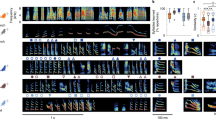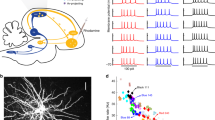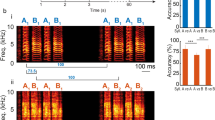Abstract
Songbirds are capable of vocal learning and communication1,2 and are ideally suited to the study of neural mechanisms of complex sensory and motor processing. Vocal communication in a noisy bird colony and vocal learning of a specific song template both require the ability to monitor auditory feedback3,4 to distinguish self-generated vocalizations from external sounds and to identify mismatches between the developing song and a memorized template acquired from a tutor5. However, neurons that respond to auditory feedback from vocal output have not been found in song-control areas despite intensive searching6,7,8. Here we investigate feedback processing outside the traditional song system, in single auditory forebrain neurons of juvenile zebra finches that were in a late developmental stage of song learning. Overall, we found similarity of spike responses during singing and during playback of the bird’s own song, with song responses commonly leading by a few milliseconds. However, brief time-locked acoustic perturbations of auditory feedback revealed complex sensitivity that could not be predicted from passive playback responses. Some neurons that responded to playback perturbations did not respond to song perturbations, which is reminiscent of sensory-motor mirror neurons8,9. By contrast, some neurons were highly feedback sensitive in that they responded vigorously to song perturbations, but not to unperturbed songs or perturbed playback. These findings suggest that a computational function of forebrain auditory areas may be to detect errors between actual feedback and mirrored feedback deriving from an internal model of the bird’s own song or that of its tutor. Such feedback-sensitive spikes could constitute the key signals that trigger adaptive motor responses to song disruptions10,11 or reinforce exploratory motor gestures for vocal learning12.
This is a preview of subscription content, access via your institution
Access options
Subscribe to this journal
Receive 51 print issues and online access
$199.00 per year
only $3.90 per issue
Buy this article
- Purchase on Springer Link
- Instant access to full article PDF
Prices may be subject to local taxes which are calculated during checkout



Similar content being viewed by others
References
Marler, P. & Tamura, M. Culturally transmitted patterns of vocal behavior in sparrows. Science 146, 1483–1486 (1964)
Thorpe, W. H. The biological significance of duetting and antiphonal song. Acta Neurobiol. Exp. (Wars.) 35, 517–528 (1975)
Konishi, M. The role of auditory feedback in the control of vocalization in the white-crowned sparrow. Z. Tierpsychol. 22, 770–783 (1965)
Brainard, M. S. & Doupe, A. J. Auditory feedback in learning and maintenance of vocal behaviour. Nature Rev. Neurosci. 1, 31–40 (2000)
Immelman, K. in Bird Vocalizations (ed. Hinde, R. A.) 61–74 (Cambridge Univ. Press, 1969)
Leonardo, A. Experimental test of the birdsong error-correction model. Proc. Natl Acad. Sci. USA 101, 16935–16940 (2004)
Kozhevnikov, A. A. & Fee, M. S. Singing-related activity of identified HVC neurons in the zebra finch. J. Neurophysiol. 97, 4271–4283 (2007)
Prather, J. F., Peters, S., Nowicki, S. & Mooney, R. Precise auditory–vocal mirroring in neurons for learned vocal communication. Nature 451, 305–310 (2008)
Rizzolatti, G. & Craighero, L. The mirror-neuron system. Annu. Rev. Neurosci. 27, 169–192 (2004)
Leonardo, A. & Konishi, M. Decrystallization of adult birdsong by perturbation of auditory feedback. Nature 399, 466–470 (1999)
Tumer, E. C. & Brainard, M. S. Performance variability enables adaptive plasticity of ‘crystallized’ adult birdsong. Nature 450, 1240–1244 (2007)
Fiete, I. R., Fee, M. S. & Seung, H. S. Model of birdsong learning based on gradient estimation by dynamic perturbation of neural conductances. J. Neurophysiol. 98, 2038–2057 (2007)
Karten, H. J. The ascending auditory pathway in the pigeon (Columba livia). II. Telencephalic projections of the nucleus ovoidalis thalami. Brain Res. 11, 134–153 (1968)
Nottebohm, F., Kelley, D. B. & Paton, J. A. Connections of vocal control nuclei in the canary telencephalon. J. Comp. Neurol. 207, 344–357 (1982)
Vates, G. E., Broome, B. M., Mello, C. V. & Nottebohm, F. Auditory pathways of caudal telencephalon and their relation to the song system of adult male zebra finches. J. Comp. Neurol. 366, 613–642 (1996)
Foster, E. F. & Bottjer, S. W. Axonal connections of the high vocal center and surrounding cortical regions in juvenile and adult male zebra finches. J. Comp. Neurol. 397, 118–138 (1998)
Zeng, S., Zhang, X., Peng, W. & Zuo, M. Immunohistochemistry and neural connectivity of the Ov shell in the songbird and their evolutionary implications. J. Comp. Neurol. 470, 192–209 (2004)
Cardin, J. A. & Schmidt, M. F. Song system auditory responses are stable and highly tuned during sedation, rapidly modulated and unselective during wakefulness, and suppressed by arousal. J. Neurophysiol. 90, 2884–2899 (2003)
Bauer, E. E. et al. A synaptic basis for auditory-vocal integration in the songbird. J. Neurosci. 28, 1509–1522 (2008)
Janata, P. & Margoliash, D. Gradual emergence of song selectivity in sensorimotor structures of the male zebra finch song system. J. Neurosci. 19, 5108–5118 (1999)
Amin, N., Grace, J. A. & Theunissen, F. E. Neural response to bird’s own song and tutor song in the zebra finch field L and caudal mesopallium. J. Comp. Physiol. A 190, 469–489 (2004)
Kimpo, R. R., Theunissen, F. E. & Doupe, A. J. Propagation of correlated activity through multiple stages of a neural circuit. J. Neurosci. 23, 5750–5761 (2003)
Hahnloser, R. H., Kozhevnikov, A. A. & Fee, M. S. Sleep-related neural activity in a premotor and a basal-ganglia pathway of the songbird. J. Neurophysiol. 96, 794–812 (2006)
Poulet, J. F. & Hedwig, B. The cellular basis of a corollary discharge. Science 311, 518–522 (2006)
Eliades, S. J. & Wang, X. Sensory-motor interaction in the primate auditory cortex during self-initiated vocalizations. J. Neurophysiol. 89, 2194–2207 (2003)
Eliades, S. J. & Wang, X. Neural substrates of vocalization feedback monitoring in primate auditory cortex. Nature 453, 1102–1106 (2008)
Jordan, M. I. & Rumelhart, D. E. Forward models: Supervised learning with a distal teacher. Cogn. Sci. 16, 307–354 (1992)
Phan, M. L., Pytte, C. L. & Vicario, D. S. Early auditory experience generates long-lasting memories that may subserve vocal learning in songbirds. Proc. Natl Acad. Sci. USA 103, 1088–1093 (2006)
London, S. E. & Clayton, D. F. Functional identification of sensory mechanisms required for developmental song learning. Nature Neurosci. 11, 579–586 (2008)
Fee, M. S. & Leonardo, A. Miniature motorized microdrive and commutator system for chronic neural recording in small animals. J. Neurosci. Methods 112, 83–94 (2001)
Acknowledgements
This work was supported by a Swiss National Science Foundation Professorship Grant to R.H.R.H. We thank K. Martin, R. Mooney and R. Douglas for comments on the manuscript.
Author Contributions G.B.K. performed the experiments and analysed the data. Both authors wrote the manuscript.
Author information
Authors and Affiliations
Corresponding author
Supplementary information
Supplementary Information
This file contains Supplementary Figures S1-S13, a Supplementary Discussion and a Supplementary Reference (PDF 3401 kb)
Rights and permissions
About this article
Cite this article
Keller, G., Hahnloser, R. Neural processing of auditory feedback during vocal practice in a songbird. Nature 457, 187–190 (2009). https://doi.org/10.1038/nature07467
Received:
Accepted:
Published:
Issue Date:
DOI: https://doi.org/10.1038/nature07467
This article is cited by
-
A perspective on neuroethology: what the past teaches us about the future of neuroethology
Journal of Comparative Physiology A (2024)
-
Visual categories and concepts in the avian brain
Animal Cognition (2023)
-
An avian cortical circuit for chunking tutor song syllables into simple vocal-motor units
Nature Communications (2020)
-
Listening to music while running alters ground reaction forces: a study of acute exposure to varying speed and loudness levels in young women and men
European Journal of Applied Physiology (2020)
-
A cortical filter that learns to suppress the acoustic consequences of movement
Nature (2018)
Comments
By submitting a comment you agree to abide by our Terms and Community Guidelines. If you find something abusive or that does not comply with our terms or guidelines please flag it as inappropriate.



